1955-1974 Buildings Rising from the Ruins
|
"I wanted to use concrete to create something powerful emerging from the rubble." True to Kenzo Tange's words, a commanding concrete structure rose from the ruins.
The Peace Memorial Museum opened in August 1955. The City Auditorium and the Peace Memorial Hall opened in March and June, respectively, initially defining what is now Peace Memorial Park. On opening, the museum displayed few artifacts and the building was plagued by flaws, but it attracted over 110,000 visitors the first year. With the generous help of the people, the collection steadily expanded.
Spindly trees were planted in the vast charred plain near the museum. Soon, people were strolling through a new park created to convey the desire for peace to people from around the world. As visitors thronged to the Hiroshima Restoration Exposition held in 1958 in Peace Memorial Park and the Museum, Hiroshima's recovery felt tangible and real.
Wrested from rubble, Peace Memorial Park and its buildings became a place to pray for the souls of the victims and communicate the damage wrought by the atomic bombs.

11*The opening of Peace Memorial Museum
1955 Peace Memorial Park
Photo by Yuichiro Sasaki Courtesy of Kiyomi Sasaki
Peace Memorial Museum opened on August 24, 1955. Appointed first director was Shogo Nagaoka, who had continued to collect A-bomb artifacts over the years. To the left looking from Peace Boulevard in the photo stands the Hiroshima City Auditorium completed on March 1 of that year. On the right stands Peace Memorial Hall, completed June 1. These buildings, along with the Cenotaph for the A-bomb Victims (unveiled in 1952), formed the basic structure of today's Peace Memorial Park.
|
 |
 |
 |
 |
 |
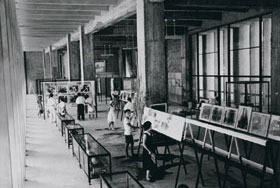
12*Twenty-yen entrance fee
August 23, 1955 Hiroshima Peace Memorial Museum
Courtesy of Chugoku Shimbun
When the museum first opened, display cases and photo panels stood on the concrete floors of bare rooms. Most of the scanty artifacts displayed had been collected by Shogo Nagaoka or the A-bomb Materials Collection Support Association (later, the A-bomb Materials Preservation Association), a grassroots organization. Even so, the museum drew 110,000 visitors its first year. The entrance fees were 20 yen for adults, 10 yen for children.
|
 |

13*Glass-walled exhibit rooms
Hiroshima Peace Memorial Museum
Photo by Ken Domon
Courtesy of Ken Domon Museum of Photography
Glass walls that fully exposed the exhibit rooms to the outside earned the building the wry nickname "bird cage." Complete protection of the artifacts was years away, as evidenced by the direct sunlight streaming through glass onto clothing and other fragile articles. When the construction budget ran out, the exterior walls were left as bare concrete instead of being covered with the planned decorative granite. The stairs lacked a railing.
|
 |
 |
 |
 |
 |
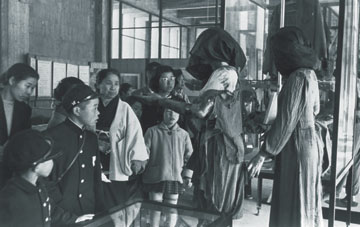
15*Visitors gazing at A-bomb artifacts
April 1957 Hiroshima Peace Memorial Museum
Courtesy of Asahi Shimbun
Some artifacts were placed in glass display cases and others simply put on display counters. Among the panels were explanations hand-written with ink and brush by museum staff. Though the displays were far from sophisticated, the items struck powerful chords in those who encountered them.
|
|
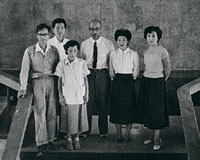
14*Eight employees at the opening
Around 1956
Stairs of the Hiroshima Peace Memorial Museum
Courtesy of Seinosuke Arata
The museum had only eight staff members when it opened: Director Nagaoka, a male clerk, a female clerk, three guards, and two custodial staff. The clerks handled sales of tickets and pamphlets. Three guards were insufficient to watch the building around the clock, so the clerks assisted in this task as well. Since the museum virtually never closed even in the early years, the staff rarely had a break. The photo, with Director Nagaoka in the middle, shows the staff members when the museum opened.
|
 |
 |
 |
 |
 |
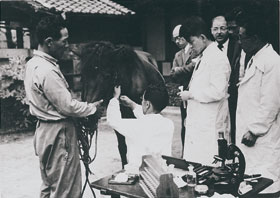
16*Investigating remnants of the atomic bombing
About 1957
Kawauchi, Sato-cho, Asa-gun (now, Kawauchi, Asa-minami-ku)
Courtesy of Seiichi Nagaoka
Despite a shortage of personnel, surveys were conducted. This photo shows museum personnel and staff of the ABCC (Atomic Bomb Casualty Commission, now, Radiation Effects Research Foundation) examining an A-bombed horse in Yokogawa-cho, 1,300 meters from the hypocenter. After the bombing, this horse worked for a farm family in the village of Kawauchi, Asa-gun. In 1958, it was put on public display at the Hiroshima Restoration Exposition. When the horse died, its hide was donated to and displayed in this museum.
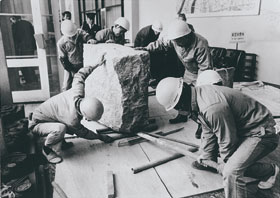
18*Preserving the "human shadow etched in stone"
February 2, 1971 Hiroshima Peace Memorial Museum
Courtesy of Chugoku Shimbun
In 1971, the "human shadow etched in stone" was donated to the museum. The "shadow" was created when atomic heat rays turned the surface of these granite steps white, leaving dark the place where someone was sitting. For 25 years, these stone steps remained in place, speaking eloquently of the cruel A-bomb tragedy. When the Hiroshima Branch of the Sumitomo Bank was renovated, they were donated for preservation and display at the museum. The photo shows the "human shadow stone" in a gallery after transfer by a crane.
|
 |

17*Restoration Exposition venue
April 1, 1958 Peace Memorial Park
Courtesy of Chugoku Shimbun
When the tape was cut, a decorative paper ball broke open and colorful balloons danced into the sky. In April 1958, three years after the museum opened, the Hiroshima Restoration Exposition was held in Peace Memorial Park and vicinity. In 50 days, the exposition drew approximately 930,000 visitors, encouraging Hiroshima residents to believe that Hiroshima had truly recovered. The museum served as venue for the nuclear power science exhibits, presenting the flow of invention and discovery from atomic physics to the peaceful use of atomic energy.
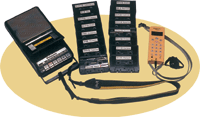
Left Sets of previous guide tapes
Right Audio guide in current use
In 1964, the museum began lending out exhibition guide audiotapes in English to help visitors from foreign countries understand the exhibits. The next year, Japanese and Chinese tapes were added. In preparation for the Hiroshima Asian Games in 1994, more languages were added, making a total of 16. The current audio guide system replaced the tape system in 2002. Each year, a total of approximately 70,000 sets are lent out in 17 languages.
|
 |
 |
 |
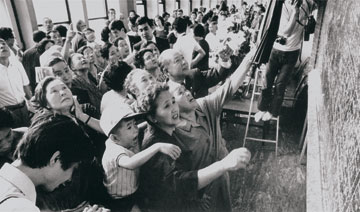 |
|

|
20*The neighborhoods directly under the A-bomb
July 9, 1972 Hiroshima Peace Memorial Museum
Courtesy of Chugoku Shimbun
In 1972, a pre-bombing map of the area that became burnt plain and then Peace Memorial Park (formerly, Nakajima district) was donated to the museum. The project to recreate the lost neighborhoods began 20 years after the bombing (1966), led by the NHK Hiroshima Central Station and the Hiroshima University Research Institute for Radiation Biology and Medicine. This photo shows former residents of the Nakajima district searching for their homes on the map on display in the museum. The copper rendition of the former neighborhoods is approximately 4 meters high and 3 meters wide.
|
|
21*Dialogue Notebooks
In 1970 the museum began making dialogue notebooks available for visitors who wish to record their impressions. The total number of notebooks, one of which contains the comments of 600 to 700 visitors, has grown to 928 (as of May 31, 2005) over 35 years. Entries are made by students on excursions, families, and persons from other countries. Ages and languages vary. Expressions of hope for peace today read much like those written 35 years ago.
|
|
|











